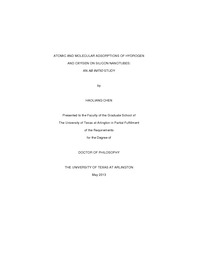| dc.description.abstract | A systematic ab initio study of silicon nanotubes (SiNTs) in single-walled, double-walled armchair and zigzag configurations will be presented. Electronic and structural properties of all these nanostructures have been calculated using hybrid density functional B3LYP and 3-21G* basis set as implemented in the GAUSSIAN 03/09 suite of software. The binding energy increases as diameter of the nanotube increases generally for both armchair and zigzag SiNTs. The HOMO-LUMO gaps of the armchair and zigzag SiNTs are in the range from 0.20 to 1.81 eV and do not show any metallic behavior. Radial buckling calculations indicate that the armchair SiNTs all have smooth tubular structure presenting the character of sp2 hybridization, and the zigzag SiNTs have a "puckered" structure presenting the character of sp3 hybridization. Double-walled armchair SiNTs with small interlayer separations, called meshed tubes, do not hold the coaxial cylindrical structure after optimization. The SiNTs (n, n)@(n+3, n+3) are found to have large formation energies and binding energies per atom. All Si nanotubes are found to be semiconductors. However, the band gap, in general, is observed to decrease from single-walled nanotubes to double-walled nanotubes.Atomic, molecular and co-adsorption of hydrogen and oxygen in nanotubes have also been studied by optimizing the distances of the adatoms or admolecules from both inside and outside the tube. The adatom or admolecule is initially placed in four adsorption sites-normal (or parallel for zigzag SiNTs) bridge, zigzag bridge, hollow and on-top sites. For single H atom adsorption, the on-top site is the most preferred site, either from the outside or the inside of the nanotubes. The O atom prefers bridge sites breaking the Si-Si covalent bond. The admolecule is originally placed perpendicular and parallel to the tube axis. Hydrogen molecule does not dissociate while oxygen molecule dissociates after optimization. The on-top site is the only preferred site for hydrogen molecule. For oxygen, the most preferred sites are the two bridge sites. Complete dissociation, partial dissociation and non-dissociation were observed for adsorption of two oxygen molecules. Peroxide structure has also been observed in adsorption of two oxygen molecules with smaller adsorption energies than complete dissociation. For the co-adsorption of one hydrogen molecule and one oxygen molecule, the oxygen molecule dissociated into two oxygen atoms and moved to bridge sites. The hydrogen molecule does not dissociate. The suppression effect on the HOMO-LUMO gap has been observed for co-adsorption of hydrogen and oxygen molecules on zigzag SiNTs. | en_US |

